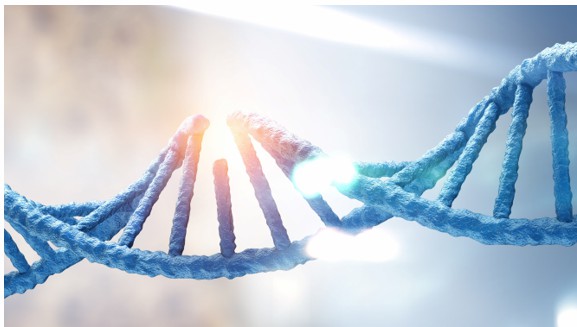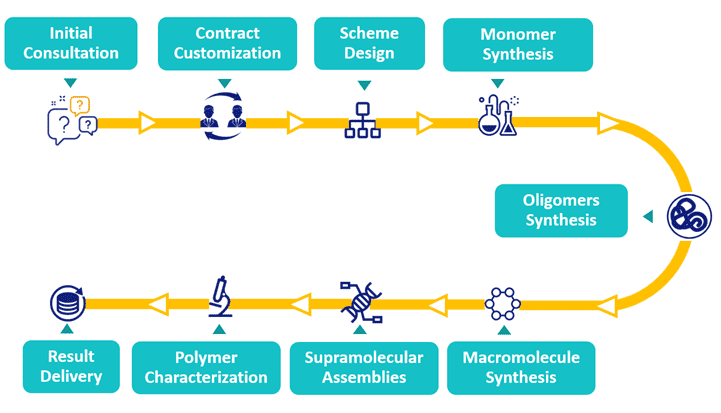DNA-Polymer Conjugation Technologies
The combination of synthetic polymers with the unique specificity and recognition properties of DNA gave rise to an all-new class of DNA-polymer hybrid materials. In recent years, DNA-polymer conjugates have emerged as versatile building blocks that provided enhanced stability to complex DNA nanostructures or facilitated, e.g., the precise organization of polymeric structures by DNA. In particular, the combination of DNA with a hydrophobic polymer chain resulted in amphiphilic species that formed supramolecular architectures such as micelles or vehicles. These assemblies were intensively investigated in the context of drug delivery, as scaffolds for directing organic reactions or as virus-like particles.

In addition to grafting to pre-synthesized polymers to DNA sequences using solid-phase synthesis or bioconjugation strategies, BOC Sciences can also achieve DNA-polymer conjugate synthesis by grafting from polymerization from the DNA sequence containing the covalently attached initiator. Our reversible-deactivation radical polymerizations technologies, such as atom transfer radical polymerization (ATRP) or reversible qddition-fragmentation chain transfer polymerization (RAFT), are often favoured by customers due to their exceptional characteristics in terms of non-demanding reaction conditions, high control over molecular weight, molecular weight distribution and end-group functionality.
Introduction of DNA-Polymer Conjugates
In DNA, the ubiquitous double helical structure is a pervasive structural component independent of the sequence combination. On the contrary, the macromolecular structure of polymers largely depends on the molecular constituents. For example, a PNIPAM grafted to a DNA oligonucleotide would very likely demonstrate very similar physical (self-assembly, LCST, etc.) and chemical behavior using any non-self-complementary sequence of the same length. Hence, the flexibility in sequence and the assurance that the oligonucleotide would possess similar physicochemical properties have fueled their wide spread application ranging from precision materials, nanorobots, ultrasensitive sensors, molecular computers, medical diagnostics, and therapeutics.
 Fig. 1. Approaches to synthesize DNA with functional handles applicable for polymer conjugation (Chem. Rev. 2021, 121(18): 11030-11084).
Fig. 1. Approaches to synthesize DNA with functional handles applicable for polymer conjugation (Chem. Rev. 2021, 121(18): 11030-11084).
DNA-directed assembly of nanoparticle based on selective molecular recognition ability of DNA has essentially overtaken other assembly strategies in recent years. For this purpose surface of nanoparticles are functionalized with single strand oligonucleotides having sequence programmability and this type of functionalization generally occurs through thiol group, covalently attached with single strand oligonucleotides. Now, the DNA-directed nanoparticle assembly can be performed using two or more nanoparticle solutions, functionalized with different but complementary single strand oligonucleotides where hybridization of the complementary DNA strands act as driving force behind this assembly process.
Our DNA-Polymer Conjugation Services
Gold Nanoparticles/Nanoclusters Synthesis Services
Gold nanoparticles (AuNPs)/gold nanoclusters (AuNC) have drawn much attention over the past decade due to facile synthesis procedure, easy surface modification, size and shape tunable optoelectronic properties, good biocompatibility and high intracellular stability. With experienced researchers and advanced polymer bioconjugation technologies, BOC Sciences focuses on developing synthesis/arrangement technologies for DNA-templated gold nanoparticles and clusters. In addition to gold nanoparticles, we also provide custom synthesis services for other DNA template nanoparticles, such as Ag, Pd, Pt, Cu, Ni, etc. Our synthetic strategies for gold nanoparticles and nanoclusters include:

Binary Nanoparticle Synthesis Services
Binary nanoparticles especially core-shell type nanomaterials have found incredible potential in emerging research areas such as in nanotechnology. In this regard, different research groups have synthesized and studied the properties as well as applications of these different core-shell nanoparticles. BOC Sciences aims to facilitate innovative research on DNA-guided synthesis of core-shell and other binary nanoparticles. Using the sequence-dependent unique recognition properties of DNA base pairs and negatively charged sugar-phosphate backbones, our R&D team can utilize multiple forms of DNA as templates and different nanostructures such as nanowires, nanorings, nanorods, nanoprticle superlattice, nanoclusters, core-shell, nano-snowman, are perfectly synthesized by bottom-up techniques.
Lithographic Nanomaterials Synthesis Services
Lithography is a popular technology that is used to create patterns with a feature size ranging from a few nanometres up to tens of millimetres. In combination with other fabrication processes such as deposition and etching, a high-resolution topography can be produced to form complex micro/nanoscale structures using lithography. Several lithographic techniques including micro-contact printing, electron-beam lithography, photolithography, nanoimprint lithography, ion-beam lithography, and some forms of scanning-probe lithography are adapted to pattern inorganic materials. BOC Sciences' polymer bioconjugation platform can combine DNA templates with top-down manufacturing operations such as lithography to achieve patterning of diverse materials with nanometrere solution. In addition, we can modify biomolecules including oligonucleotides, peptides and proteins.
Our DNA-polymer Synthesis Strategies

Our Polymer Bioconjugation Workflow

References
- Weil, T. et al. Polymer bioconjugates: modern design concepts toward precision hybrid materials. Progress in Polymer Science. 2020, 105: 101241.
- Schuster, G.B. et al. Precise sequence control in linear and cyclic copolymers of 2,5-bis(2-thienyl)pyrrole and aniline by DNA-programmed assembly. J. Am. Chem. Soc. 2013, 135(11): 4438-4449.
- Nandi, A.K. et al. Nucleic acid based polymer and nanoparticle conjugates: synthesis, properties and application. Progress in Materials Science. 2017, 88: 136-185.


 Fig. 1. Approaches to synthesize DNA with functional handles applicable for polymer conjugation (Chem. Rev. 2021, 121(18): 11030-11084).
Fig. 1. Approaches to synthesize DNA with functional handles applicable for polymer conjugation (Chem. Rev. 2021, 121(18): 11030-11084).








